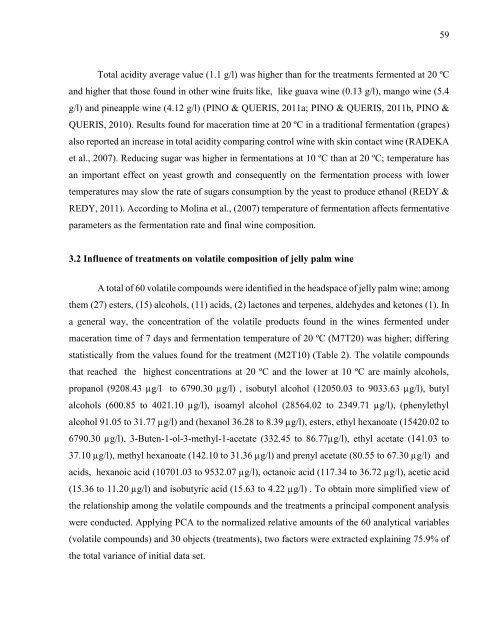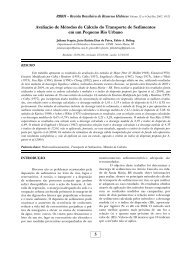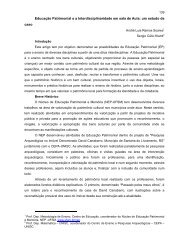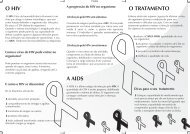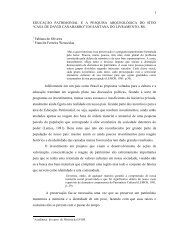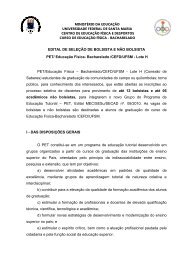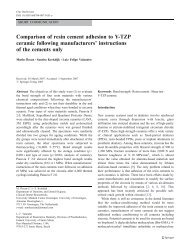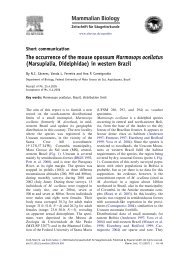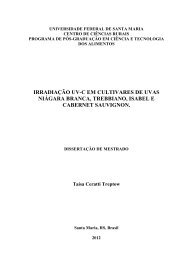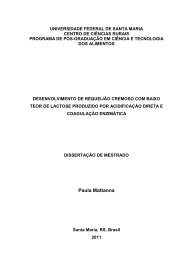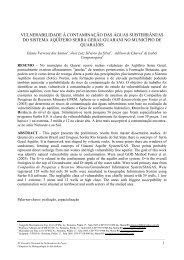DESENVOLVIMENTO E CARACTERIZAÇÃO FÃSICO ... - UFSM
DESENVOLVIMENTO E CARACTERIZAÇÃO FÃSICO ... - UFSM
DESENVOLVIMENTO E CARACTERIZAÇÃO FÃSICO ... - UFSM
Create successful ePaper yourself
Turn your PDF publications into a flip-book with our unique Google optimized e-Paper software.
59<br />
Total acidity average value (1.1 g/l) was higher than for the treatments fermented at 20 ºC<br />
and higher that those found in other wine fruits like, like guava wine (0.13 g/l), mango wine (5.4<br />
g/l) and pineapple wine (4.12 g/l) (PINO & QUERIS, 2011a; PINO & QUERIS, 2011b, PINO &<br />
QUERIS, 2010). Results found for maceration time at 20 ºC in a traditional fermentation (grapes)<br />
also reported an increase in total acidity comparing control wine with skin contact wine (RADEKA<br />
et al., 2007). Reducing sugar was higher in fermentations at 10 ºC than at 20 ºC; temperature has<br />
an important effect on yeast growth and consequently on the fermentation process with lower<br />
temperatures may slow the rate of sugars consumption by the yeast to produce ethanol (REDY &<br />
REDY, 2011). According to Molina et al., (2007) temperature of fermentation affects fermentative<br />
parameters as the fermentation rate and final wine composition.<br />
3.2 Influence of treatments on volatile composition of jelly palm wine<br />
A total of 60 volatile compounds were identified in the headspace of jelly palm wine; among<br />
them (27) esters, (15) alcohols, (11) acids, (2) lactones and terpenes, aldehydes and ketones (1). In<br />
a general way, the concentration of the volatile products found in the wines fermented under<br />
maceration time of 7 days and fermentation temperature of 20 ºC (M7T20) was higher; differing<br />
statistically from the values found for the treatment (M2T10) (Table 2). The volatile compounds<br />
that reached the highest concentrations at 20 ºC and the lower at 10 ºC are mainly alcohols,<br />
propanol (9208.43 µg/l to 6790.30 µg/l) , isobutyl alcohol (12050.03 to 9033.63 µg/l), butyl<br />
alcohols (600.85 to 4021.10 µg/l), isoamyl alcohol (28564.02 to 2349.71 µg/l), (phenylethyl<br />
alcohol 91.05 to 31.77 µg/l) and (hexanol 36.28 to 8.39 µg/l), esters, ethyl hexanoate (15420.02 to<br />
6790.30 µg/l), 3-Buten-1-ol-3-methyl-1-acetate (332.45 to 86.77µg/l), ethyl acetate (141.03 to<br />
37.10 µg/l), methyl hexanoate (142.10 to 31.36 µg/l) and prenyl acetate (80.55 to 67.30 µg/l) and<br />
acids, hexanoic acid (10701.03 to 9532.07 µg/l), octanoic acid (117.34 to 36.72 µg/l), acetic acid<br />
(15.36 to 11.20 µg/l) and isobutyric acid (15.63 to 4.22 µg/l) . To obtain more simplified view of<br />
the relationship among the volatile compounds and the treatments a principal component analysis<br />
were conducted. Applying PCA to the normalized relative amounts of the 60 analytical variables<br />
(volatile compounds) and 30 objects (treatments), two factors were extracted explaining 75.9% of<br />
the total variance of initial data set.


